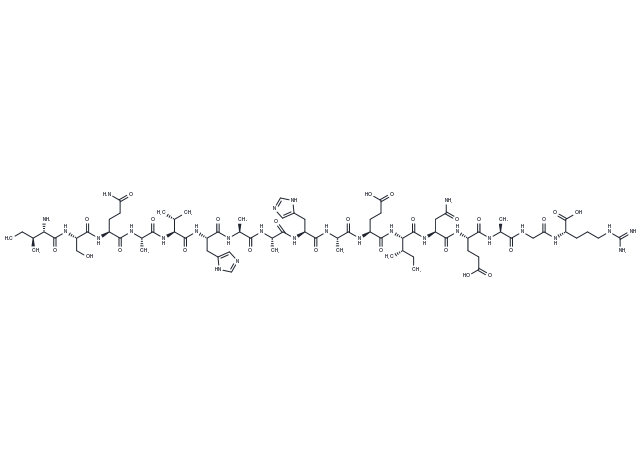keep away from moisture
Powder: -20°C for 3 years | In solvent: -80°C for 1 year

OVA Peptide (323-339) constitutes a T and B cell epitope derived from Ovalbumin (Ova), crucial for eliciting immediate hypersensitivity reactions in BALB/c mice.

| Pack Size | Availability | Price/USD | Quantity |
|---|---|---|---|
| 5 mg | Inquiry | Inquiry | |
| 50 mg | Inquiry | Inquiry |
| Description | OVA Peptide (323-339) constitutes a T and B cell epitope derived from Ovalbumin (Ova), crucial for eliciting immediate hypersensitivity reactions in BALB/c mice. |
| In vitro | When pulsed with 0.01 μM of OVA Peptide (323-339), B cells expressing M2, in comparison with those expressing M2Y, led to an increased number of T_H cells mobilizing calcium. To assess whether B cells expressing M2 could also promote a stronger individual response, we quantified the 405/530 ratio mean fluorescence intensity (MFI) of the reactive T_H cells [1]. |
| In vivo | OVA Peptide (323-339) is a critical epitope for both T and B cells in the rapid development of hypersensitivity reactions in BALB/c mice. Daily nebulization of OVA Peptide (323-339) for 20 minutes over 10 days proves as effective as natural OVA sensitization via the same route in eliciting serum anti-OVA IgE antibody responses. Following natural OVA sensitization, the majority of the IgE anti-OVA response targets OVA Peptide (323-339). Both OVA and its peptide induce similar pulmonary inflammation, as assessed by eosin/hematoxylin and major basic protein immunohistochemical staining. Interestingly, significant increases in serum total IgE and OVA-specific IgE are observed in OVA mice compared to saline controls. Mice exposed to OVA Peptide (323-339) exhibit higher serum levels of OVA-specific IgE, peptide-specific IgE, IL-4, and lower IFN-γ, similar to OVA mice. Proliferative responses to OVA are noted in cultured splenocytes from both OVA and OVA Peptide (323-339) mice, while responses to the peptide alone are observed only in the peptide-sensitized and challenged mice. Despite OVA Peptide (323-339) inducing Th2-like responses in mice as OVA does, its immunogenic potency in activating splenocytes from OVA-sensitized and challenged mice is notably limited compared to OVA [2]. |
| Molecular Weight | 1773.9 |
| Formula | C74H120N26O25 |
| CAS No. | 92915-79-2 |
keep away from moisture
Powder: -20°C for 3 years | In solvent: -80°C for 1 year
You can also refer to dose conversion for different animals. More
bottom
Please see Inhibitor Handling Instructions for more frequently ask questions. Topics include: how to prepare stock solutions, how to store products, and cautions on cell-based assays & animal experiments, etc.
OVA Peptide (323-339) 92915-79-2 inhibitor inhibit
